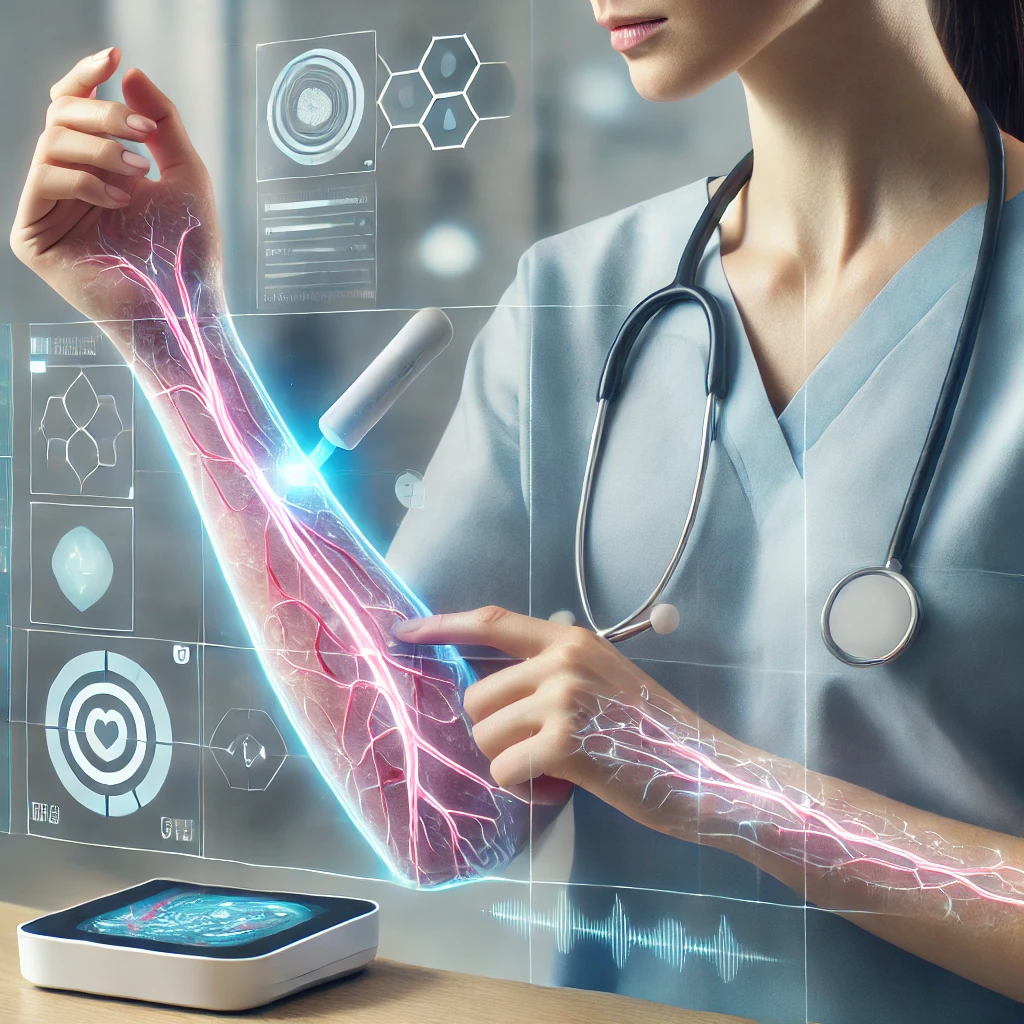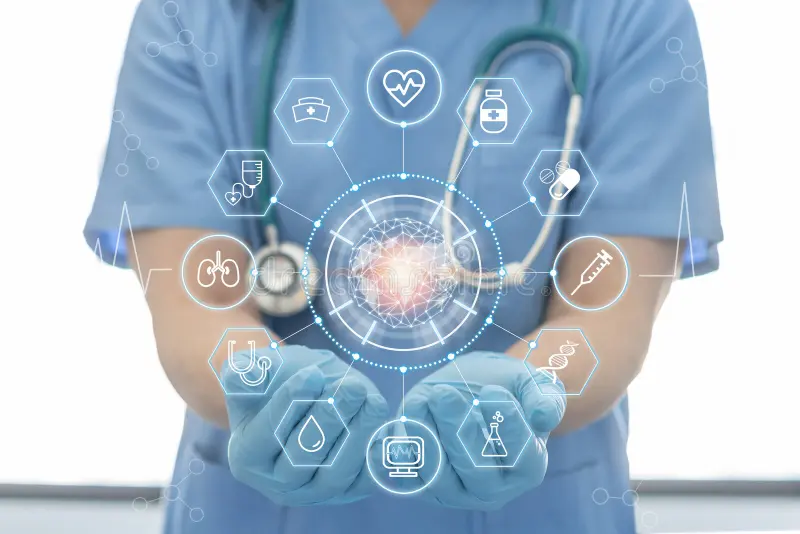Drug-testing operations and medical procedures innovate drastically on account of augmented reality vein finders. Healthcare professionals using augmented reality technology gain real-time vein visibility to raise their venipuncture procedure effectiveness and reduce both operational time and success failure rates. The tool assists medical professionals to achieve two essential outcomes through better needle positioning success and reduced discomfort for patients and superior healthcare delivery. This paper investigates how augmented reality vein finders contribute to healthcare practice changes through beneficial impacts on both medical personnel and their patient clientele.
Impact of Augmented Reality Vein Finders on Healthcare
The augmented reality vein finder maintains its position as the most innovative medical device which specifically benefits phlebotomy workflows. Advanced AR technological functionalities enable the device to display patient vein projections on the skin which enhances medical staff visibility during vein location procedures. Healthcare providers have consistently struggled with vein detection tasks when they need to work with patients who have poorly visible veins. The newly introduced technology of AR vein finders removes the requirement for guessing during procedures.
Patients experience better enhancement through AR vein finders because these devices enable fewer needle introductions. The technology provides real-time viewing of veins which improves both abandonment rates and venipuncture success ratios. Medical personnel benefit from two advantages when using this advanced system since it provides both precise treatment results and better patient satisfaction levels.
The Technology Behind Augmented Reality Vein Finders
The main operational mechanism of augmented reality vein finders relies on infrared light technology and augmented reality software to display hidden veins underneath the skin. An infrared light detection system in the device detects blood vessels through the skin and then displays them electronically on the patient’s skin surface using AR technology.
The effective performance of enhanced technology stems from its precise presentation of current vein positions beneath medical procedure locations. The AR features produce improved visualizations of veins that medical personnel can easily locate directly on the skin surface.
A data analysis system operates through IR light detection of blood hemoglobin to generate data findings. The sensor detects blood hemoglobin absorption through blood tests to produce an interactive display of hidden veins underneath. The patient receives visual insights through the technological display which displays their vascular system clearly on their skin surface.
The Technology Behind Augmented Reality Vein Finders
The main operational mechanism of augmented reality vein finders relies on infrared light technology and augmented reality software to display hidden veins underneath the skin. An infrared light detection system in the device detects blood vessels through the skin and then displays them electronically on the patient’s skin surface using AR technology.
The effective performance of enhanced technology stems from its precise presentation of current vein positions beneath medical procedure locations. The AR features produce improved visualizations of veins that medical personnel can easily locate directly on the skin surface.
A data analysis system operates through IR light detection of blood hemoglobin to generate data findings. The sensor detects blood hemoglobin absorption through blood tests to produce an interactive display of hidden veins underneath. The patient receives visual insights through the technological display which displays their vascular system clearly on their skin surface.
The Role of Augmented Reality in Healthcare and Patient Experience
The healthcare industry finds augmented reality helpful for searching veins since this technology has operated in medical settings for a long period. Patients benefit from real-time vein mapping technology in procedures because healthcare providers achieve better outcomes along with lower treatment-related distress.
Medical patients experience increased benefits from both shorter needle procedures and reduced pain alongside expedited procedure execution. Patience faces discomfort and nervousness during the traditional vein detection method since repeated unsuccessful attempts are necessary to find suitable veins. AR vein finders remove various challenges which enable healthcare providers to deliver enjoyable patient procedures.
The success rate of medical procedures improves and work performance increases as the technology shortens procedure durations. The visualization screen for veins adds to provider work efficiency through increased effectiveness during operations.
Benefits of Using an Augmented Reality Vein Finder
The integration of augmented reality vein finders throughout medical facilities leads to both improved patient health outcomes and improved satisfaction levels of medical patients. Organizations that use augmented reality vein finders benefit from exact results and improved operational speed and lower expenses to generate better treatment effects.
Improved Accuracy and Reduced Error Rates
An augmented reality vein finder presents exceptional accuracy as its defining advantageous quality for users. Multiple medical staff face difficulties when trying to identify veins in patients who have challenging veins for visualization. AR vein finders reduce the process uncertainty through their ability to show vein visualization during actual operations.
Augmented reality vein finders provide medical staff with exact vein visualization which helps them perform fewer unsuccessful venipuncture attempts leading to decreased incidence of tissue-damage and bruisings and extravasations. Augmented reality equipment enables healthcare providers to enhance both precision and reliability in their treatment so they reduce the discomfort of patients and improve medical outcomes.
Faster Procedures and Reduced Patient Discomfort
Medical personnel can conduct their tasks more efficiently through the AR vein finder system because it boosts productivity and speed in busy clinical settings. Medical personnel reduce their procedure durations and needle and catheter insertion trials through precise vein mapping methods.
Such technology generates quick operations which leads to improved patient comfort levels. The manual needle insertion approach results in patient discomfort at every time point when healthcare providers must redo their attempts because target areas are not properly identified. Patient distress decreases through the implementation of augmented reality vein finders since they reduce the number of times healthcare practitioners must repeat vein access procedures.
Cost-Effective Solution for Medical Facilities
Responsible healthcare facilities should prioritize these capital-intensive augmented reality vein finder investments which produce cost-saving benefits that ultimately make them affordable solutions for the long run. Medical supply costs decrease and healthcare worker efficiency enhances due to AR vein finders which minimize lengthy procedures that end in failure.
Better patient outcomes and reduced procedural complications enable medical facilities to receive improved hospital reviews thus leading to better patient retention while minimizing medical error lawsuits.
The Future of Augmented Reality in Healthcare
The fast growth of augmented reality applications in healthcare during upcoming years stems from the ability of AR vein finders to launch more complex medical equipment. AR technology will develop additional functionality that leads to better benefits for healthcare providers as well as their patients.
Enhanced AR Capabilities for Comprehensive Diagnostic Tools
Upgraded versions of augmented reality vein finders will transform from simple vein display technologies into advanced diagnostic tools available to medical professionals. The evolved versions of AR vein finder technology will enable connectivity with imaging systems that present live visualization of entire patient anatomical structures.
By placing different imaging systems onto one AR display healthcare providers can reach maximum accuracy during surgical decision-making processes.
Augmented Reality Vein Finders in Remote Healthcare and Telemedicine
AR vein finder devices will become vital medical tools because remote healthcare delivery systems are expanding to serve patients who need distant healthcare services. Remote AR systems managed by healthcare providers offer step-by-step assistance to patients with venipuncture procedures performed at their homes.
Home healthcare services will obtain new opportunities through this technology because patients can receive superior care at home instead of going to traditional healthcare locations. Scientific applications of remote assistance within AR systems indicate promising outcomes for patient success while delivering health services to underserved territories.
Challenges of Implementing Augmented Reality Vein Finders
Medical practitioners need existing technical problems resolved for augmented reality vein finders before this technology can become their standard operational technique.
High Initial Costs and Training Requirements
Medical organizations including compact hospitals as well as hospitals with limited funding frequently decide against purchasing expensive augmented reality vein finders. Medical facilities devote major funds to buy healthcare devices at the same time healthcare providers need deep training to effectively utilize the technology.
The rising demand for AR technology leads to a decreasing price threshold making it attainable in the market. The time will reveal easier training requirements for professionals who operate with AR devices because more healthcare staff learn this technology.
Technological Limitations and Reliability Concerns
Augmented reality vein finders experience different limitations as part of their standing as a recently developed technology. Professional performance with infrared imaging technology may decrease while working with black skin patients and during specific types of environmental lighting exposure.
The high accuracy level from AR vein finders needs medical experts with practice to combine their skills with professional judgment in their work. The system delivers its most beneficial results when used to help clinicians however it must not become a substitute for the needed medical expertise.
Conclusion:
Patients benefit from augmented reality vein finders in medical settings through a more efficient venipuncture process which simultaneously delivers increased accuracy along with decreased treatment pain. Better patient outcomes result from these tools that combine infrared cameras with AR features to display veins during real-time use. Progressive advances in augmented reality technology will continuously deliver benefits that transform healthcare into operations which are more productive and less expensive and designed for patients. Healthcare professionals utilize augmented practices at various levels within their current operations.





